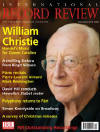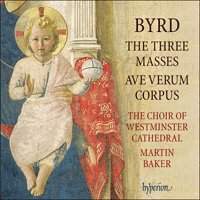Texte paru dans: / Appeared in:
*

International Record Review - (12//2014)
Pour
s'abonner / Subscription information
Hyperion
CDA68038

Code-barres / Barcode : 0034571280387
(ID464)
Consultez toutes les évaluations recensées pour ce cd
~~~~ Reach all the evaluations located for this CD
Byrd's three settings of the Roman Catholic Mass Ordinary were published in the last decade of the sixteenth century, when it was still forbidden for English Catholics to practise their faith in public. So it's fair to assume that one of the reasons for the relative directness of all three settings ‑ in publication order, the Mass for four voices, then three, then five ‑ is to ensure their accessibility by non‑professional (which isn't the same as untrained) singers worshipping in secret. That's not to say there isn't ~ direct relationship between words and music ‑ most profoundly in parts of the 'Gloria', the 'Credo' and, in the five‑part Mass, the magnificent 'Agnus Dei' ‑ but by and large this is music that seems to combine the best of the past: the continental stile antiche and the robustness of the earlier Tudor masters.
Still, this is essentially vocal chamber music, and any performance, even in one as cavernous as Westminster Cathedral, must reflect this fact. A mixed chamber choir such as The Sixteen can capture both the surface intimacy and the underlying passion of Byrd's Masses. An elite Anglican cathedral choir such as Christ Church Cathedral Choir, Oxford, under Stephen Darlington, can capture both the clean, cogent force of Byrd's musical arguments and the ethereal nature of the text's imports. But surely only a working, English Catholic 'choir such as Westminster's under. director Martin Baker can capture both its significance in the context of a living, breathing liturgical experience and an authenticity born of absolute fluency.
Moreover, these fine performances, superbly recorded by Hyperion, do manage to reflect the chamber‑like nature of the works in a certain delicacy of attack while adopting a speed appropriate to such a large acoustic in order to maintain clarity. You can hear this to best effect in the 'Sanctus' and 'Agnus Dei' of each Mass, and especially in Byrd's luminous four‑part motet Ave verum corpus with which the recording ends. And if some commentators have criticized the discrepancy between the vibratos of the outer voices (virtually non‑existent in the trebles, much wider in the basses), I don't see that as a problem at all. Again, this is a working choir; and indeed, in keeping with a more continental sound, absolute blending of sound is less a priority than the kind of variegated colours you would have had from those recusant amateur singers in Byrd's time.
Cliquez l'un ou l'autre
bouton pour découvrir bien d'autres critiques de CD
Click either button for many other reviews


